Fiber is an essential piece to the health puzzle but can you be eating too much? In this blog post we’ll go over what fiber is, the different types, benefits, and what happens if you eat too much of it.
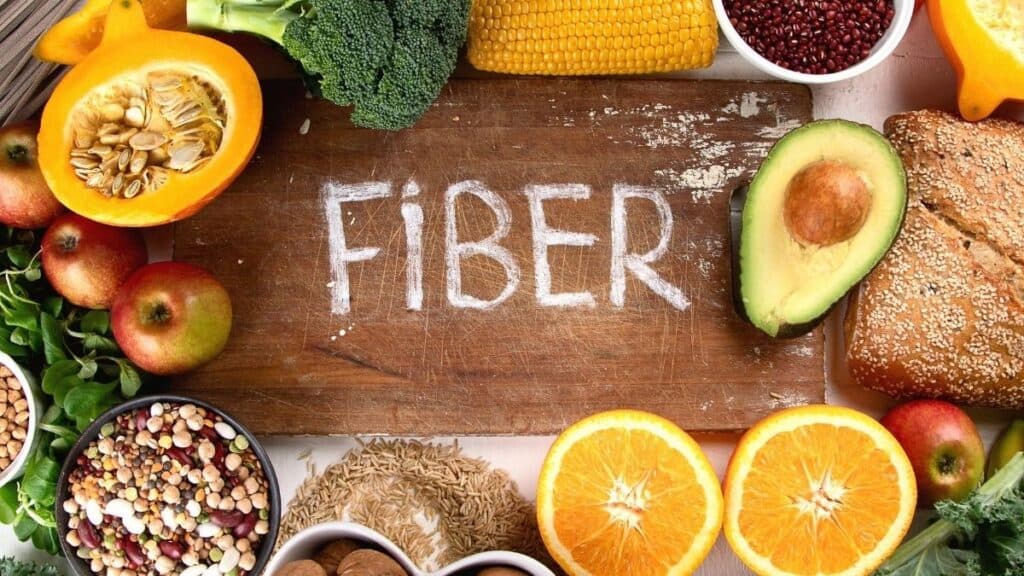
What Is Fiber?
Fiber is a fascinating type of carbohydrate in the fact that the body doesn’t actually break it down into energy, like it does other carbohydrates. Yet, our body still needs it to function properly and optimally.
Fiber, also known as dietary fiber, comes from plants (as opposed to animal products). There are two types of dietary fiber: soluble fiber and insoluble fiber.
Types Of Fiber
Soluble Fiber
Soluble fiber is a type of fiber that absorbs water. Think of it kinda like a sponge. This type is more easily fermented by our gut bacteria. Soluble fiber has prebiotic functions, so this type is great for gut health.
You can get soluble fiber from a variety of foods such as: beans, oat cereals, flax seeds, and most veggies.
Insoluble Fiber
Now, on the flip side we have insoluble fiber. This type does NOT soak up water, like soluble does. It doesn’t change as it travels through your digestive system in the same way that soluble does. Essentially, it provides bulk.
Insoluble fiber also promotes gut health, as it also has prebiotic benefits and helps to “clean you out”, keeping bowels regular.
You can get insoluble fiber from whole grains, root vegetables, corn, and also beans.
It’s not uncommon for a food to contain both soluble and insoluble fiber, like how you see beans on both lists! However, different sources may have differing amounts of each. Here is a little run down of the two types with some sources (these are just a few!):
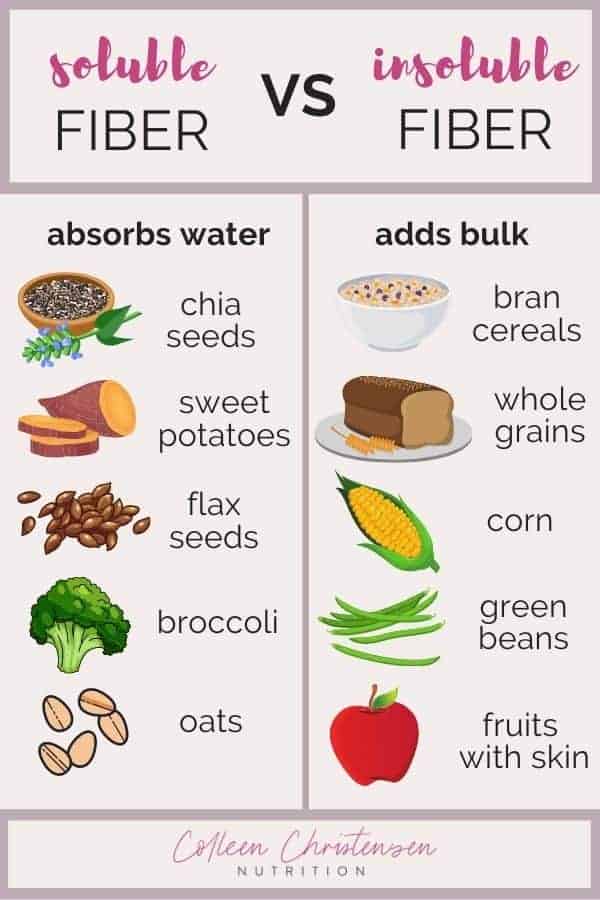
Health Benefits Of Fiber
There are a SLEW of health benefits associated with adequate fiber intakes such as:
- lowering cholesterol (the soluble fiber essentially absorbs it up)
- promoting digestive regularity (helps things “move along”, increases fecal bulk, and improved overall environment of your gut- the flora)
- protects against chronic disease (diabetes, metabolic syndrome, CVD, colorectal cancer)
- increases satiety & meal absorption (and induction of cholecystokinin, a satiety hormone)
- decrease circulating levels of C-Reactive protein (CRP) (this is a marker of inflammation in the body)
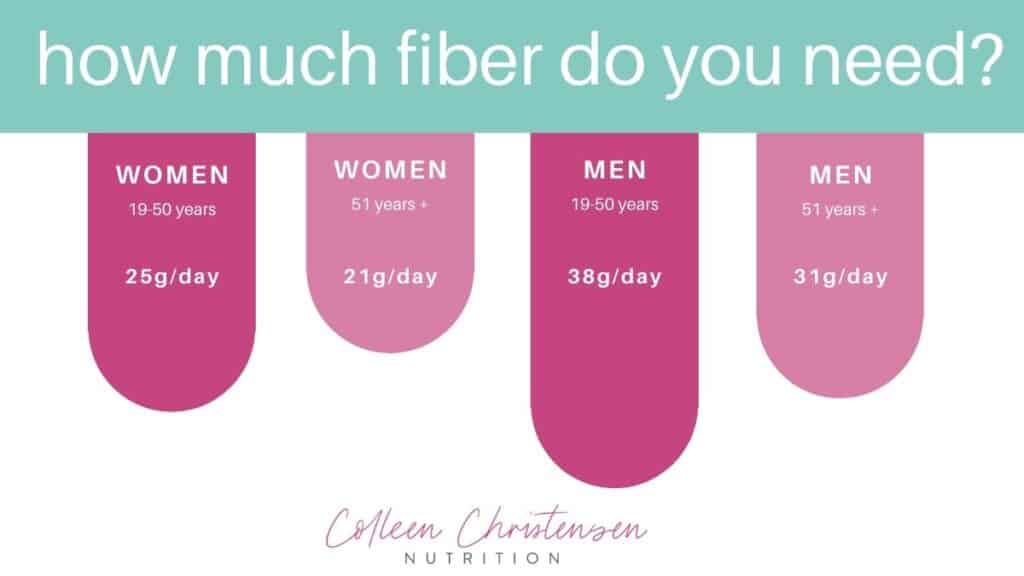
I talk more about additional benefits to a plant based diet, including a higher fiber intake, in my blog post about the whole foods plant based diet (WFPB Diet). Be sure to give that a read for more benefits of a plant based diet, as well as some potential downfalls to be aware of!
How Much Do We Need?
Here is the rundown of how much most adults need in a day:
- Women ages 19-50: 25g/day
- Women ages 51+: 21g/day
- Men ages 19-50: 38g/day
- Men ages 51+: 31g/day
Now these are total amounts of dietary fiber, including both the soluble and the insoluble.
The average American doesn’t reach these recommended amounts on the daily. The average intake is about 15g per day. However, with the growing popularity of supplement use and “clean eating” (like the whole foods plant based diet), getting over the recommended amount can be a concern for some.

What Are The Symptoms Of Too Much?
There is currently no tolerable upper limit (UL) for fiber intake. A UL is the highest intake that likely won’t have any adverse health effects for most individuals. However, tolerance of fiber varies from person to person. Meaning, one person may be able to handle more in their diet than another person can.
For example, person A might not get constipated from eating a high fiber diet, while person B might not be able to poop for days. This is why it’s so important to listen to your own body, not just read a recommendation and take it as the be all and end all! Our bodies are fascinating and nutrition truly must be individualized. We talk about this a lot in The SociEATy!
Another thing to note is that while we may have an overall tolerance to different levels of fiber, it can also take time for your body to adjust to various intakes of fiber. For instance, if you eat protein bar that is high in fiber but typically eat a relatively low fiber diet, you may experience more symptoms of having too much fiber than someone else who typically eats a higher fiber diet may.
Here are some signs and symptoms that you might be eating too much:
- Excessive bloating
- Pressure in your stomach (gas)
- Flatulence
- Constipation (you can’t poop!)
- Diarrhea (it can go both ways!)
- Feeling too full and loss of appetite

What Does Too Much Fiber Do To Your Poop?
You’ll notice that both constipation and diarrhea are on the symptoms list, how can that be?! Well, diarrhea happens when your food is just moving too fast, remember it helps move things along.
Constipation can happen because of the bulk created by the fiber. When paired with not drinking enough water to help things move along, well, ya got troubles poopin’.
If you’re struggling with diarrhea, you might try adding some of that soluble fiber to help absorb some of the water. Insoluble might worsen it, since it’s going to keep things movin’ along.
If you’ve got constipation, you might try adding insoluble fiber to get things moving. I’d also recommend drinking water to help!
Now, you don’t want to just keep adding more and more insoluble fiber as that can contribute to your bowels being backed up too. If you’re eating loads of it (like, tons of protein bars jam-packed with over half of your day’s needs!) it might actually be helpful to decrease your intake.
One study showed that decreasing fiber intake could help with constipation. The group of participants who were experiencing constipation and reduced fiber intake had an increase in their amount of bowel movements. Whereas those who continued on a higher fiber diet did not.

Can Too Much Fiber Cause Weight Gain?
Like I mentioned, fiber is a type of carbohydrate and today’s society is basically (wrongfully) terrified to eat carbs because we think carbs are horrible for you and cause weight gain. This is utterly untrue.
Firstly, I’d encourage you to read my blog post on the set point weight theory and also this one on wanting weight loss. The research continues to tell us that intentionally trying to lose weight typically leads to weight cycling (weight loss, then gaining it back and likely then some) which actually increases our risk for disease. And, also, health promoting behaviors are a stronger predictor of health than weight is. You truly CAN be healthy at any size. It’s honestly NOT about the number.
Secondly, carbs are not bad. Carbs contain energy, nutrients like fiber, and let’s be honest, taste delicious! The fiber found in carbs helps to promote feelings of fullness and satiety. This is not to say “Fiber keeps you from eating!” No. Remember how loss of appetite was on the list of symptoms of too much?
It is sometimes used in popular fad diets as a “trick” to weight loss. However, this will likely re-bound, as most diets do. Your body will start to realize that the fullness isn’t from energy (calories) and it’s actually in a large caloric deficit. This will likely lead you to feeling out of control around food and binge eating. This isn’t a lack of your willpower, it’s your body trying to get the energy it needs to survive. I talk more about why we binge in this blog post.
Moral of the story here: don’t be scared that it will cause weight gain because it’s a carb. More so, don’t be scared of weight gain! Weight gain is a natural thing that happens throughout our lives, doesn’t determine your health status, and the fear of weight gain actually leads to worse health in the form of either undernutrition or weight cycling.

When Should You Take Fiber Supplements?
To the average person, I don’t recommend taking fiber supplements. As a Registered Dietitian I always recommend food first. It’s easier, cheaper, and you can likely get more nutritional “bang” for your “buck” with food.
A supplement would be something to look into if you’re unable to meet your needs through food, in which case I’d highly recommend working with a Registered Dietitian 1:1. And I don’t mean if you can’t meet your needs because you’re on the keto diet and are avoiding carbs. You CAN meet your fiber needs, you’re just choosing not to.
So, How Do I Make Sure I’m Eating Enough Fiber?
While, yes, it’s important to make sure that you’re getting enough fiber in a day for your body to function optimally, I do not recommend counting grams of it. That will likely lead to disordered eating, like obsession with tracking the numbers or fear of foods that might not have as much in them.
Instead, I would say simply try to include a few sources into your day. I don’t recommend focusing too much on soluble VS insoluble sources, as you’ll typically find both in foods as I mentioned. Try including a variety of sources to ensure you’re getting each instead of, say, just picking one fave food and only eating that.
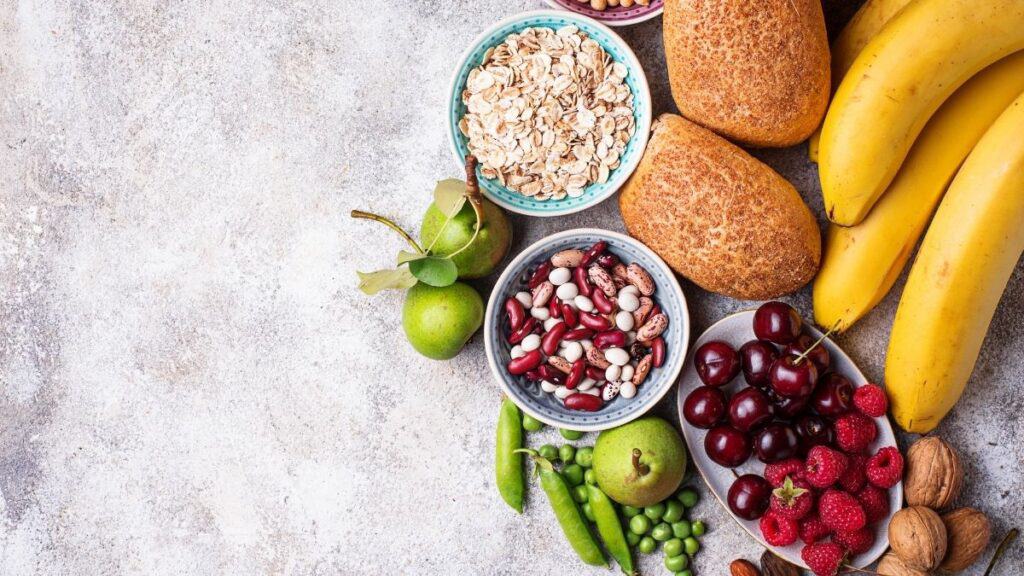
First, focus on doing this and take note of how you feel. Don’t worry about the different types, focus on overall. Simply keep that knowledge of the different types in the back of your mind for those times when you might feel backed up or if you can’t seem to stop running to the bathroom!
Something we use in the SociEATy is called a “food and mood journal”. It’s not a food journal where you log your foods, it’s where you can make observations and correlations about the way you feel and your eating style.
For instance, you might jot down how you feel on a day where you eat multiple fiber containing foods VS a day when you don’t. How do you FEEL. Not in the sense of “I feel good for being “healthy” and eating fiber”. I mean, how does your BODY feel. Were you more energized? Have less obsessive thoughts of food? Etc.
Making these connections is how nutrition and eating “healthy” becomes easy and second nature. It’s intuitive eating. (Read this blog post to learn more about that!) You truly let your BODY be your guide! No googling meal plans or diets. So much easier, right?! It’s what I call gentle nutrition.
Ideas For Increasing Intake
If you need some ideas for ways to deliciously and easily add some to your day here are a few of my faves:
- Make some crispy chicken nuggets with bran cereal
- Enjoy some toast smeared with a heaping of this easy 2 ingredient blueberry jam (thickened with chia seeds!)
- Use a whole wheat tortilla for a delicious quesadilla
- Whip up a batch of baked whole wheat donuts or use whole wheat flour in my fave banana carrot muffin recipe
- Add sweet potato fries to this hamburger salad recipe (AKA Big Mac in A Bowl, a go-to dinner of mine!)
- Make some creamy overnight protein oats for breakfast
Let me know in the comments what some of your favorite ways to add fiber to your day are! Be sure to pin this blog post and all of the ideas for increasing your fiber intake to your Pinterest board to come back to!
XOXO
-Colleen
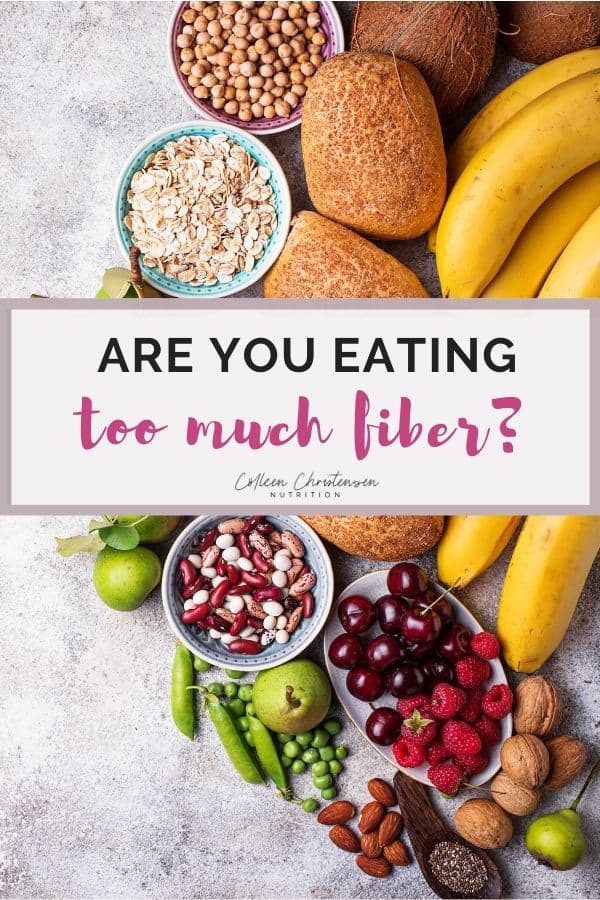
This blog post was written by Colleen Christensen, RD and researched with the help of Amy Sharn, MS, RDN.
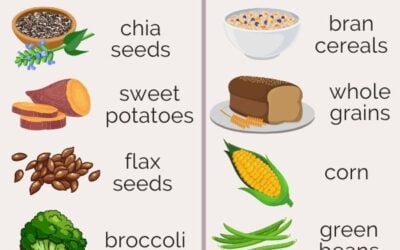
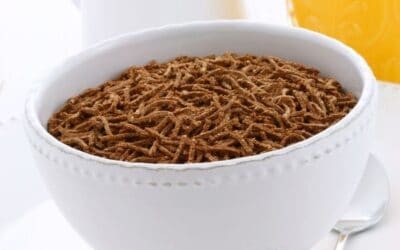
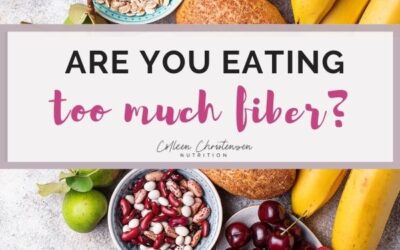



Katherine says
In one video you recommended sprinkling flax seeds on peanut butter and banana toast. I love it! It adds a new flavor and a little crunch. It also helps get in a little extra fiber in the morning. Thanks for the recommendation!
Colleen says
Love that too!!! So glad you’re enjoying that combo!
Inge says
I’ve noticed that these past few months I tend to bloat and get quite flatulent either some time after lunch or later in the evening. I always “go” in the morning, first thing. But my stool has been really loose. Not watery diarrhea, but has no shape or any form. I’m eating really healthy and think I might be getting in too much fiber. I’m not a big fan of meat or too much lower fiber carbs like rice or potatoes. Especially in summer now I’m eating less cooked veg and more raw. Tips to reduce fiber intake and still eat healthy in summer?
Colleen says
You could try carrots or tomatoes. Cooking will help, too!
Amber says
TMI but any idea why I may be getting this terrible constipation + diarrhea (feeling like I’m going to run to the bathroom but nothing comes – sometimes 10+ times a day for a day or two) after eating too much oatmeal? Specifically oatmeal. 😔
Colleen says
Hi! I’d highly recommend chatting with your doctor about this! There could be something more going on than just the fiber content